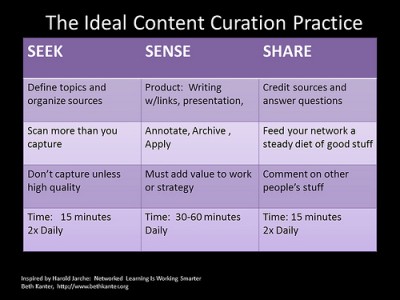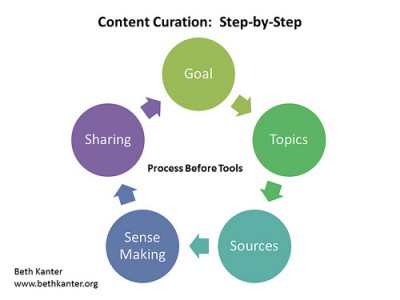Rhondda Powling was part of a group, including staff from the State Library of Victoria, who presented at SLAV ‘s ‘Be in control: participate in the new age of school libraries’ on the value of personal learning networks, workflows and online tools. This guest post reflects on her presentation exploring content curation. You can find Rhondda’s blog here.
I was asked to speak about ‘Content Curation’ at a recent SLAV conference. You could say a lot about curation but I was asked to do two short sessions about ten minutes long. What to include in this brief session and what to leave out was a conundrum. I wanted the topic of curation to make sense. I tried to focus my thoughts on what I believe curation means to me. Why is it important to my learning, how do I use it with colleagues and students and why should I? So this is my experience of curation.
The phrases ‘content curation’ and ‘digital curation’ are buzz words in the online world, especially in my library networks. Although curation tools are many and varied, the approach I take when running sessions for teachers at my school is that when used properly, these tools enhance professional learning.
The AITSL Professional Standards for Teachers includes a section on Professional Engagement. The first paragraph under this is ‘Teachers model effective learning’. They identify their own learning needs and analyse, evaluate and expand their professional learning, both with colleagues and individually. One of the ways to demonstrate this kind of learning is through professional reading. It is easy to keep a record of professional reading and evidence of learning and sharing if you become a good content curator. Content curation also covers the collegial aspect.
Content or digital curation is not simply collecting links. Many teacher librarians, myself included, have been collecting links (for example: school topics, research) for years. So:
- it’s not really a creating process as such but rather a process of sorting, arranging and then further publishing about information that already exists in the online or digital world
- it is a process of first finding digital content that might be useful then sorting the results into the best and most relevant links, value adding with annotations and then sharing them in meaningful (organized) ways.
Good curators identify and define their topics or subjects at the outset. They then select what to keep whilst providing some context and annotation. Good curators make sure they correctly credit the sources as they offer their networks appropriate and easy access to their curated sources.
How to begin curating
Focused filtering and selection is a very important aspect of effective curation. Try to be as clear as possible about what you want. There are many ways to locate good content especially if you use social media. There are also many tools for curating. See my Google doc for some suggestions These are tools I use or others that I have seen. Some I do not use myself but they are recommended by other colleagues. Another post about curation tools that is worth looking at is 55 Content Curation Tools To Discover & Share Digital Content, which includes an annotated list, from the TeachThought blog.
Robin Good is an expert when it comes to the topic of content curation. He has extensive knowledge of the practices and tools and his comprehensive map of content curation tools and skills is divided into key categories. There are over 250 tools in this collection, so be prepared and take it slowly.
I have found that the best way to choose a curation tool is to be as clear as possible about what you want then spend some time looking for the tool/s that best suit your needs. That means, as you begin, have a ‘play’ with different tools and evaluate them critically. Some tools offer more advanced filtering search options than others. Some are more visual. Of course, as with everything in the digital world, things may change and what works for a while may alter its perspective and/or no longer continue to meet your needs.
I use around five main tools that allow me to find information and links. I actively search for information on specific topics and follow a number of people and groups using social media who have similar interests to me. These include my Diigo groups, Scoop.it and Paper.li authors via gmail notifications and summaries. I usually get daily, but sometimes weekly, summaries sent to me.
I do not regard Twitter as a curation tool but I find it very useful (via groups and hashtags) to locate possibly useful content. If I don’t have time to read it fully, I use Diigo’s “read later” option to help me filter out what I want to annotate and keep. Twitter is also one of the ways I inform others in my networks about possible sources that may also be of interest to them. Pinterest and Scoop.it are both curation tools that I use often and they make it easy to share to other social media platforms.
When I first began I looked at what others were doing. Here are a selection of people I follow:
- Joyce Valenza Scoop.it ; Paper.li
- Judy O’Connell Scoop.it ; Paper.li ;
- Robin Good Scoop.it
- Judith Way Paper.li
- Liberrygrl (Library Tech Daily) Paper.li
- Heather Baillie’s article in SLAV’s FYI magazine
- In 2011 Beth Kanter wrote a very good post about content creation. I really liked her approach summarised by the graphic below.
I think it is important that the task of curating becomes a regular one, part of the daily routine. Beth’s suggestion about timing is a good one. I try to go through my lists most days. If, after a week I haven’t got to suggested sites, I usually delete the suggested lists, as new ones keep coming in.
My time was up. This was as far I got with my coverage of the topic. There is more I could discuss especially how it might be used to assist student learning.
I left the group with a second graphic that offers a good visual about the process of curating.
And these videos about why it’s important to curate.
Image credit: Alfred E. McMicken, (1936) Greenville Public Library, [mobile library service] [picture], State Library of Victoria Pictures Collection.


